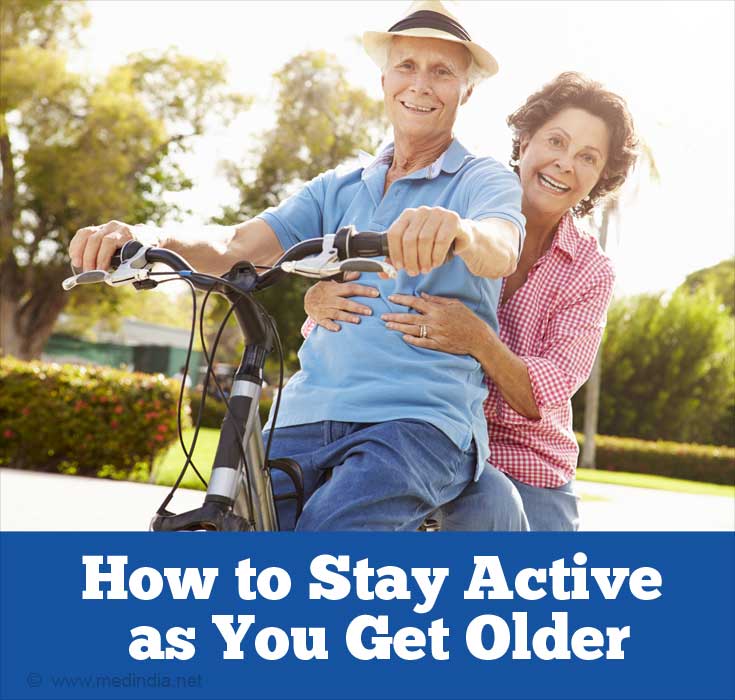- Staying Active As You Age - (http://orthoinfo.aaos.org/topic.cfm?topic=a00103)
- Senior Exercise and Fitness Tips - (http://www.helpguide.org/articles/exercise-fitness/exercise-and-fitness-as-you-age.htm)
- Stay Active As You Get Older: Quick tips - (http://healthfinder.gov/HealthTopics/Category/health-conditions-and-diseases/obesity/stay-active-as-you-get-older-quick-tips)
- Physical activity guidelines for older adults - (http://www.nhs.uk/Livewell/fitness/Pages/physical-activity-guidelines-for-older-adults.aspx#moderate)
How Physical Activity Helps You to Stay Active?
Healthy and active lifestyle with a lot of physical activity, either through routine or leisure activities, is one of the ways to stay healthy and age gracefully.
Physical exercise may not always be possible for the elderly as the aging process also involves reduction in muscle mass, wear and tear of muscles and joints, etc. The impact of poor health can directly affect the motivation to exercise. But, physical activity can actually go a long way in helping anyone overcome illnesses.

Why do you need to Stay Fit?
Leading a sedentary lifestyle can pave way for diseases such as obesity and heart disease. It weakens bones and makes the elderly dependent on someone else. When dependency leads to frustration, it can also push them into depression.
Benefits of staying active in old age:
- Helps to stay independent
- Boosts metabolic rate, helps in healthy weight management and maintains ideal muscle mass
- The sense of balancing is maintained, and reflexes are kept active, which in turn reduces the risk of falls
- Improves flexibility of the body
- Increases bone density, and prevents osteoporosis
- Helps prevent serious health conditions like heart attack, diabetes, stroke, etc
- Elevates mood and reduces the risk of depression
- Exercising in groups can improve social life. A walk in the park also fetches more friends
How Much Physical Activity is required for the Elderly People?
The requirement of physical activity for older people depends on their health conditions and mobility of the body. Adults aged 65 years or older ideally require:
- About 30 minutes of moderate exercise, 5 days a week.
- Muscle strengthening exercises for 2 or more days a week. The muscles of the legs, hips, abdomen, shoulders, chest, back and arms must be stretched and strengthened.
A senior person can engage in vigorous aerobic activity, like jogging, aerobics or a game of tennis, if his or her body conditions permit. Consulting a doctor before going for vigorous activity is a must.

Cardio endurance exercises: The exercises that get your heart pumping include brisk walking, climbing stairs, hiking, cycling, swimming, rowing, dancing and tennis. A schedule that incorporates 30 minutes of any of these, 5 days a week, can help keep up the oxygen levels and therefore energy levels.
Strength and power training: Repeated motion using weights or elastic bands can help prevent loss of bone mass and muscle mass. This improves balance and strength and also keeps the reflexes going.
Stretching exercises: Stretching your muscles and joints can help keep them in full range of motion. Stretching exercises reduces the impact of the injury to the muscles and joints.
Ways to Stay Active as You Get Older
Water aerobics: Working out in water can be less painful on the muscles and joints.
Tai Chi and Qi Gong: These are movements inspired by martial arts and are excellent for improving strength and balance.
Yoga: Yoga involves breathing right, stretching exercises and working on individual muscles. This improves strength, flexibility and balance on the body level. It also helps in better maintenance of cognitive skills like memory, concentration and alertness. Yoga is also beneficial to older adults who suffer from aches and pains.

Daily life activities: Activities involving daily routine can be made fun and also a means of keeping active. Some such activities include:
- For light aerobic-type activities - Cleaning the house, gardening, shopping
- For strength training - Lifting young children, carrying groceries or shopping bags, lifting things while doing household chores
- Stretching - Picking up things from the floor, tying shoelaces
Some minor changes in an exercise routine can help make exercising a fun activity:
- Listen to music while exercising
- Take photographs with your walking buddies or with the nature at the park
- Watch a favorite television program while on the treadmill
- Play tennis with partners
- Find an exercise buddy and compare your exercise schedules and weight loss rates
Some minor changes in lifestyle that can help you stay active:
- Walk the golf course instead of asking for a ride in the cart
- Choose to use the rake to clear up leaves in the backyard, instead of using a leaf blower.
- Sweep the sidewalk
- Instead of chatting with a friend over coffee, go for walks together
- Walk your dog every day
- When you are stressed or feeling depressed, go for a short walk down the lane. It not only takes you away for a while but also produces “feel-good” hormones in the blood.
- Park your car at the farthest parking slot and walk your way to the mall
- Walk down every aisle of the departmental store while shopping
- While waiting for your water or milk to boil, don’t just stand there. Stretch yourself, do push-ups on the wall, try toe-raises or do knee bends
- While talking over the phone, keep walking or pacing up and down instead of sitting and talking.
How to Exercise when there is a Change in the Routine
Life isn’t all about following the same routine always. While you have settled down, life surprises you with a little twist of events. Maintaining the exercise schedule or physical activity levels becomes even more imperative in such situations.
Exercising while on a vacation: Most of the hotels have fitness centers. Find a suitable one for your vacation. Take along the exercise clothing like swimsuits, walking shoes, etc. Exercise bands are easy to carry along while on a vacation. Instead of taking a car or bus, keep a maximum walking schedule during sight-seeing.
When your exercise buddy moves away: Go for a new exercise buddy while keeping in touch with the old one. Join a gym or aerobics class and make new friends.
When you relocate: Check out fitness centers and join classes. Take a stroll in the park to watch who is walking regularly and make friends with them.
A friend or family who moved in with you: This sure changes your routine. But do not forget physical activity. The best way to stay active is to involve your newcomer in the physical exercise routine, too.
Caring for an ill spouse: Ask a family or friend to be with him or her, while you go for your walk. You can also do low impact aerobics at home, while your spouse is taking rest.
Mild illnesses or flu that makes you go off-track: Once you have recovered from the fever or flu, start slowly by walking inside the house. Once you get the energy back, gradually build up activities to your previous schedule.
After undergoing surgery: If you had to undergo a surgery that has disrupted your activity levels, discuss with the doctor about how to resume the exercises. Talk to the doctor about any specific activities that need to be done, or avoided.











